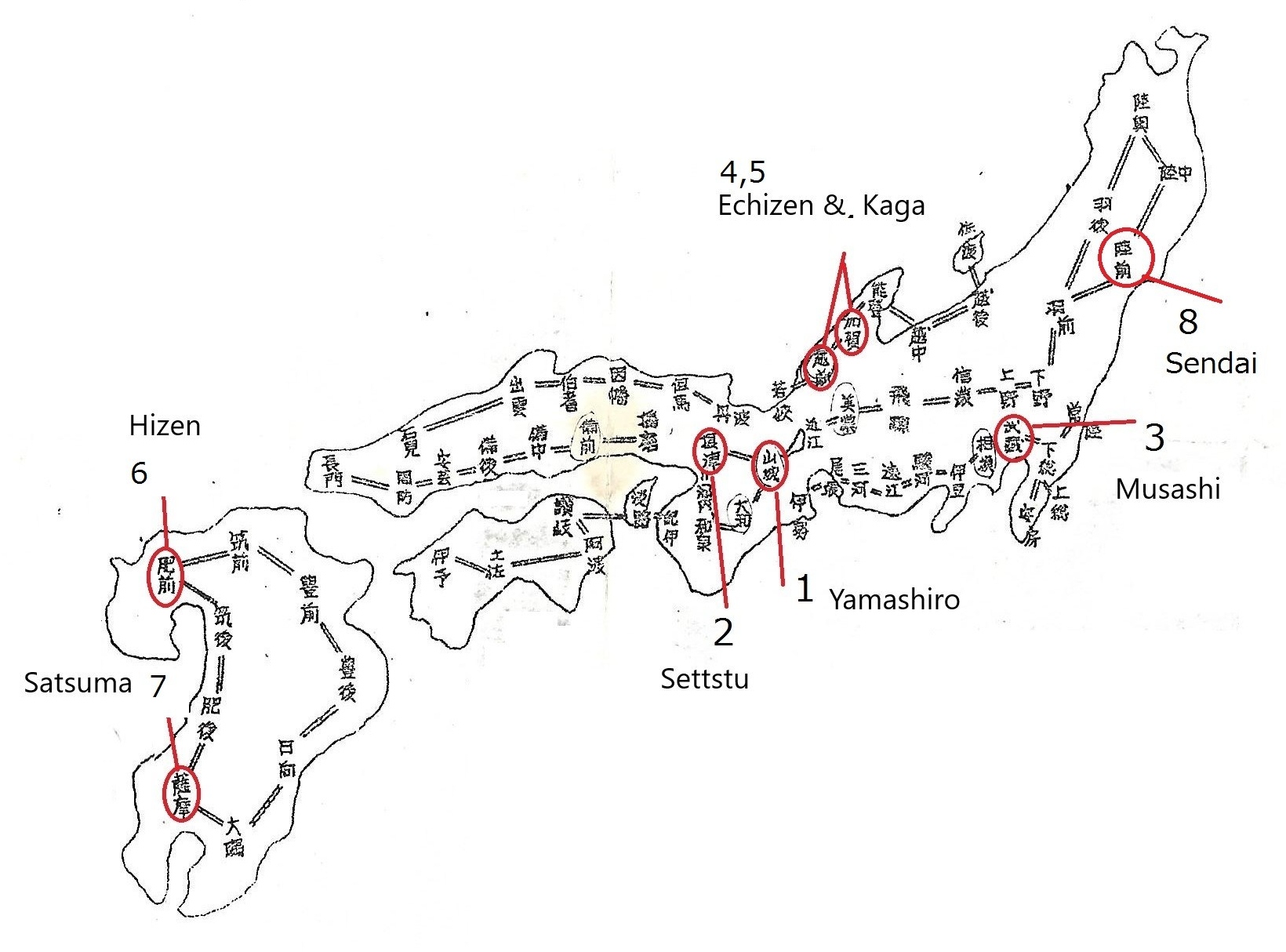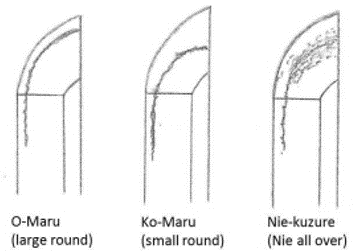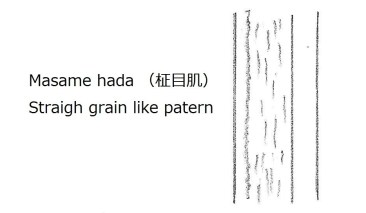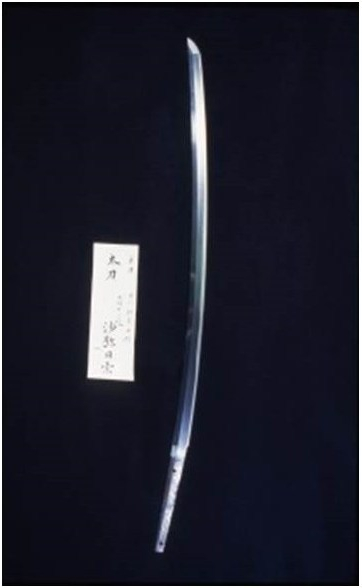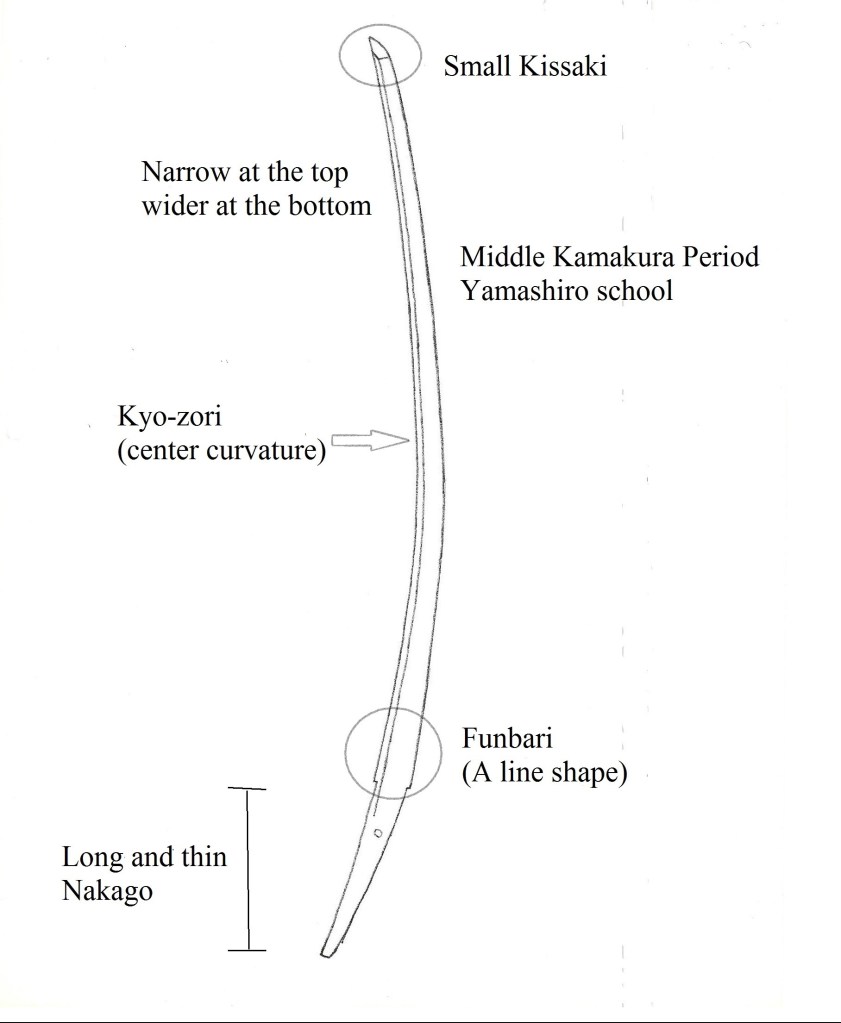This chapter is a continued part of Chapter 5 Heian Period Sword. Please read Chapter 5 before reading this section. More sword terminologies will be used in the coming chapters. They were explained between chapters 1 to 31. For unfamiliar sword terminologies, please read chapter 1 to 31.
 The red circle above indicates the time we discuss in this sect
The red circle above indicates the time we discuss in this sect
There are several active schools of swordsmiths during the Heian period. We use the word “Den” for school. They are Yamashiro Den (山城伝), Yamato Den (大和伝), Bizen Den (備前伝). Also, the following areas are other active groups during the Heian period: Houki-no-Kuni (伯耆の国), and Oo-U (奥羽). Oo-U is pronounced “Oh,” and “U” as uber.
Yamashiro Den (山城伝 )
During the Heian period, among Yamashiro Den swords, the most famous sword was “Mikazuki Munechika “ (三日月宗近) by Sanjo Munechika (三条宗近). Mikazuki means crescent. It was named Mikazuki Munechika because the crescent-shaped Uchinoke (collection of Nie) pattern appears in Hamon. It has a graceful shape, narrow-body, Koshi-zori, Funbari, and small Kissaki. It shows the wood grain pattern surface and Suguha with Nie mixed with small irregular, sometimes Nijyu-ha (double Hamon: 二重刃) appears. Sanjo Munechika lived in the Sanjo area in Kyoto. His sword style was carried on by his sons and grandsons: Sanjo Yoshiie (三条吉家), Gojo Kanenaga (五条兼永), and Gojo Kuninaga (五条国永 ). Gojo is also an area in Kyoto.

三日月宗近 Mikazuki Munechika 東京国立博物館蔵 Tokyo National Museum Photo from “Showa Dai Mei-to Zufu 昭和大名刀図譜” published by NBTHK
Houki -no-Kuni (伯耆の国)
Houki-no-Kuni is today’s Tottori Prefecture. It is known as the place to produce good iron. The sword, “Doujigiri Yasutsuna” (童子切安綱) made by Houki-no-Yasutsuna (伯耆の安綱) was one of the famous swords during the time.
The characteristics of Yasutsuna’s sword———-It has a graceful shape with small Kissaki, narrow Hamon (often Suguha with Ko-choji), coarse Nie on Hamon area, large wood grain pattern mixed with Masame on Ji-hada. Hamon area often shows Inazuma and Kinsuji. Boshi area is Yakizume, Kaen (pronounced ka as a calf, en as engineer) with a small turn back.

伯耆の安綱 (Hoki no Yasutsuna) 佐野美術館図録 (Sano Musem Catalogue) Permission to use granted
Bizen Den (備前伝 )
Bizen is today’s Okayama Prefecture. It is known as the place to produce good iron. From the Heian period until now, Bizen has been famous for the sword-making tradition. The sword-making group in this area during the Heian period was called the Ko-bizen group. The most famous swordsmith in the Ko-bizen group was Bizen Tomonari (備前友成), Bizen Masatsune (備前正恒), and Bizen Kanehira (備前包平).
Ko-bizen group’s characteristics ——- A graceful narrow body, small Kissaki, narrow tempered line with Ko-choji (small irregular) with Inazuma and Kin-suji. Ji-hada is a small wood grain pattern.

Bizen Kanehira (備前包平) Sano Museum Catalogue (佐野美術館図録) (Permission to use granted)
I saw Ko-Bizen Sanetsune (真恒) at Mori Sensei’s house. That was one of the Kantei-to of that day. I received Douzen*ᴵ. The book written by Hon’ami Koson was used as our textbook. Each time I saw a sword at Mori Sensei’s house, I noted the date on the swordsmith’s name in the book we used. It was Nov. 22, 1970. It had a narrow body line, small kissaki (that was Ko-bizen Komaru), Kamasu*2 (no fukura), and Suguha. Kamasu is the condition where the fukura (arc) is much lesser than usual. Thinking back then, it is amazing we could see famous swords like this as our study materials.
Kantei-Kai
Kantei-kai is a study meeting. Usually, several swords are displayed, with the Nakago part being covered. The attendees guess the name of the sword maker and hand in the answer sheet to the judge. Below are the grades.
Atari —– If the answer is right on the exact name, you get Atari. That is the best answer.
Dozen —- The second best is dozen. It means almost the right answer. The subject sword was made by the family or the clan of the right Den. Dozen is considered very good. It indicates the student has a good knowledge of the particular group.
Kaido Yoshi —– This means correct about the line, but not about the family.
Jidai Yoshi——- It means the time or period is right. Each Kantei-kai has different grading systems. Some may not have “Jidai Yoshi” grade.
Hazure—– the wrong answer.
After all the answer sheets are handed in, the answer sheets are graded and returned. The judge reveals the correct answer and explains why.
*1 Dozen: Almost the same as the correct answer.
*2 Kamasu: The name of a fish. It has a narrow and pointed head.













